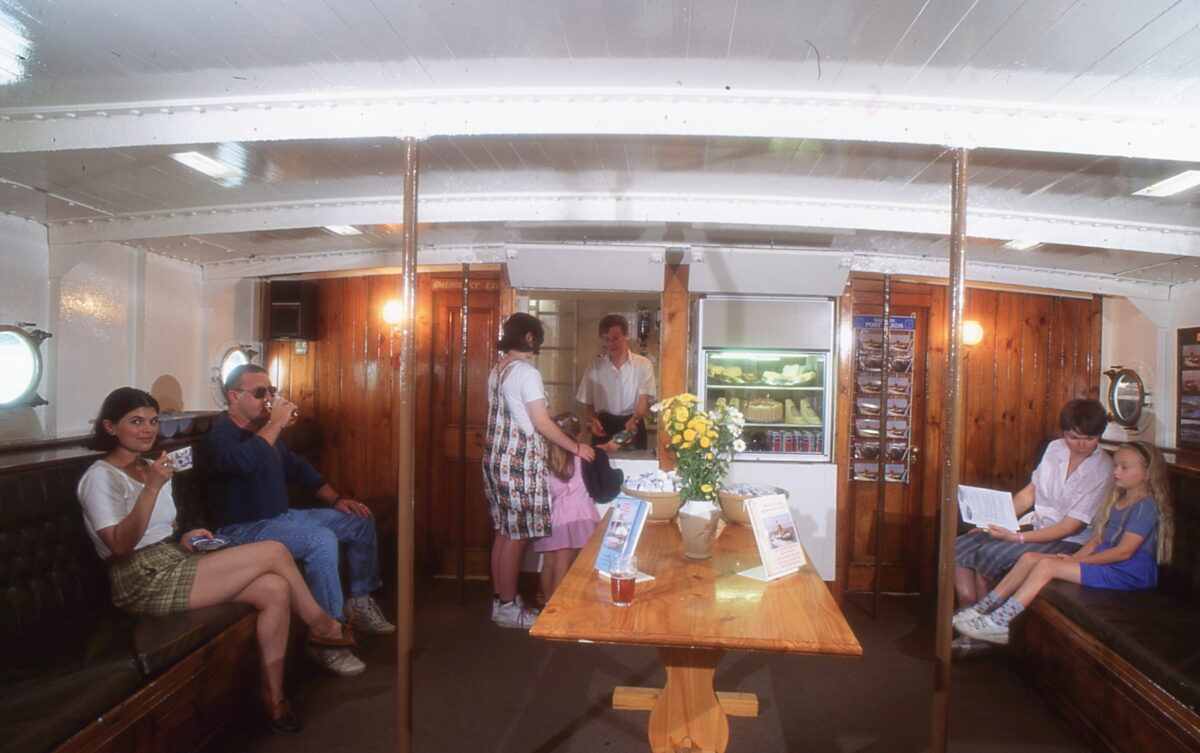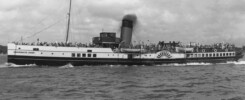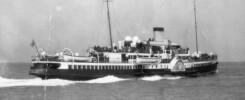
On Saturday 18th June 1960 Monarch departed from her usual Saturday schedule in June on the Swanage service to run a special trip to view the Royal Yacht Britannia with the newly married Princess Margaret and Anthony Armstrong Jones aboard at Portsmouth. The day dawned overcast and with a light breeze but by lunchtime the sun had come out which made for a lovely afternoon.

Further down the steamer notice promises “Sailing in the sheltered waters of the Solent” in an effort to try to encourage passengers up the gangway who might otherwise have thought that a long day trip from Bournemouth was synonymous with being sea-sick. It also says in bold type “You must book early to avoid disappointment”. They needn’t have worried. As it turned out although there was a good crowd waiting for Monarch on Bournemouth Pier she sailed at 9.30am nowhere near her maximum capacity of 746 under the command of Capt Harry Defrates, with Arthur Drage as mate and Alf Pover as chief engineer.
The steamer notice also advertised “Lunch or light refreshments will be available on board also fully licensed bars”. And therein lay the rub. On the Swanage service passengers were aboard Monarch for 45 minutes. When she ran to Totland Bay or Yarmouth that extended to an hour and a half. People don’t have to eat and drink on trips of that length. They can make do with the prospect of being catered for whilst ashore at their destination if they haven’t brought something themselves.
However an eight and a half hour trip is a different ball game with all the potentially hungry passengers trapped aboard for the duration. Of course in those days not so many people wanted to eat out as do today. Many took their own packed lunches in tin boxes and their drinks in flasks. But some did want to eat and drink aboard and take up the promise offered within the steamer notice. Unfortunately Monarch’s catering facilities were wholly inadequate to service a high demand for cooked meals on this or any other day.
The galley, and a small pantry next to it, were accommodated in the port sponson aft of the paddle box opposite the engine room with the galley being equipped with a coal-fired range which, according to Monarch’s design specification book which I have here, was 6ft 6ins long. The range took up the whole of the forrard end of this tiny galley space with a small bunker for coal to fire it on its outboard side. The aft end of the galley was given over to a marble worktop with shelves above it and a sink on its outboard side. This was a galley smaller than most people’s domestic kitchens today.

The bar on the main deck aft of the engine was small and didn’t extend the full width of the ship with alleyways outside it just like on some of the Swiss lake steamers today. And its size was further reduced by accommodating the ladies’ lavatories at its aft end. It had a seating capacity at best for up to 30 and that would have been a tight fit.

The dining saloon on the lower deck aft was also not large and had its size further reduced by accommodating a pantry at its forrard end on the port side and a large dresser on the starboard side. The ship’s General Arrangement plan shows the placing of a total of four long tables as indicated in the picture above with seats around them for a total of just 35 seated diners.
Dating from her days as a two class ship on the Southern Railway’s Portsmouth to Ryde ferry service, there was also the old second class bar and dining saloon on the lower deck forrard of the boiler. This again was not a large space and was made all the smaller by the aft end being taken up with cabins for the mate and the engineer. The General Arrangement plan shows four tables laid out here each capable of hosting eight diners around them giving a seated total of 32. So even adding this space to the main dining saloon on the lower deck aft there was sufficient seated capacity for less than 70 diners at any one time on a ship with a Board of Trade Passenger Certificate for 746.
Cosens recognised this inherent weakness in the business model and as a result such dinners as they did provide aboard Monarch were simple fayre which made use of ingredients like ham and eggs. You can store a lot of ham and eggs in a relatively small space. It takes only minutes to fry an egg. The ham doesn’t need cooking and can be served cold.
Many of the passengers aboard that day were keen royalists of the kind ever eager to be on the periphery of regal events and ever hopeful of catching a glimpse of the Queen’s sister or other royalty. There was also a cluster of enthusiasts from the then only recently formed PSPS including Bernard Cox who took cine film of the day and used it in one of his later paddle steamer videos.
Tiny Point of Detail: Look again at the picture of the dining saloon and you will see that there are two vases of flowers set out in the centre. This was a constant feature in the saloons of Cosens’s paddle steamers. I always felt that these flowers enhanced the saloons’ ambience and helped to take the customer experience up a level.

I remembered that from my childhood and so when I came to spend nearly three decades running Kingswear Castle on the Medway and Thames, I also bought bunches of flowers every week for her two saloons.
Kingswear Castle returned to service in 2023 after the first part of a major rebuild which is designed to set her up for the next 25 years running on the River Dart. The Paddle Steamer Kingswear Castle Trust is now fund raising for the second phase of the rebuild. You can read more about the rebuilds and how you can help if you can here.
John Megoran
This article was first published on 18th June 2021.


